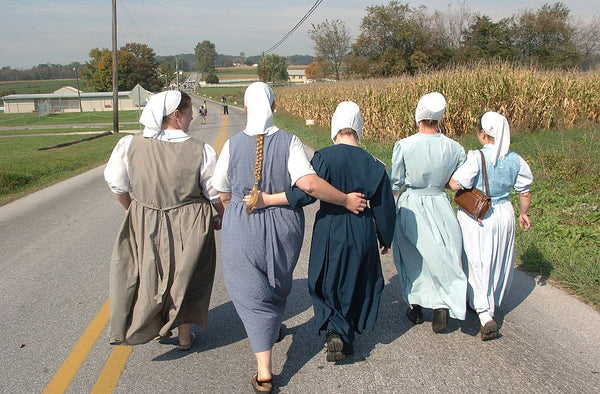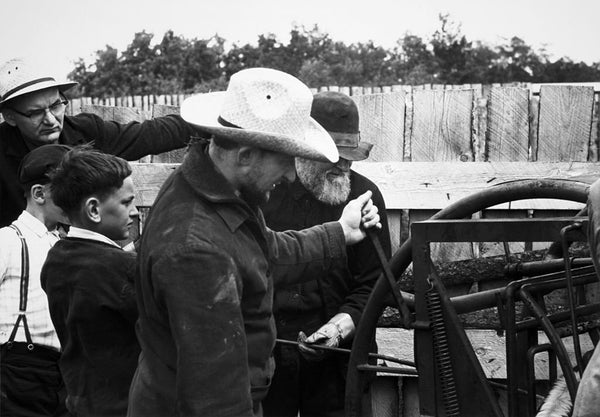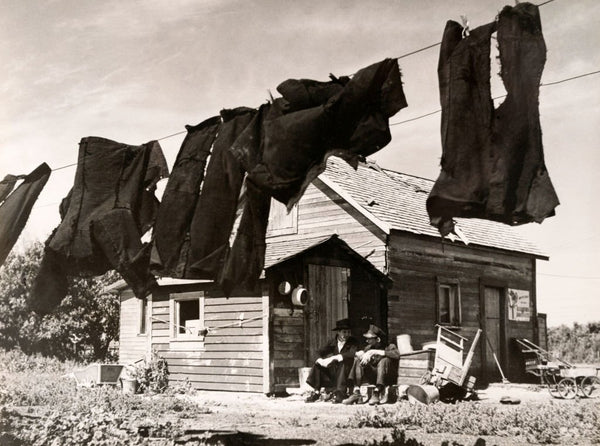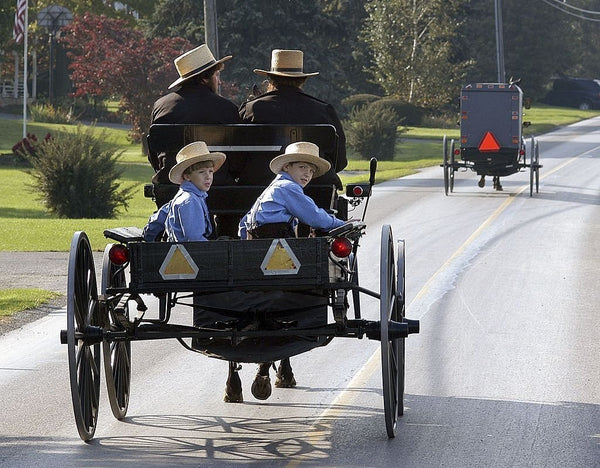One of the problems the Amish community faces is outsiders’ constant confusion between them and similar groups like the Hutterites. But you can be forgiven for this mistake. After all, they dress similarly, and also descend from the Anabaptist movement in Europe. But are they really so similar?
While they share certain traits, there are distinct differences between these two groups. Want to know more about them? In this comparison guide on the Hutterites vs Amish, you’ll learn some interesting facts about the Hutterites and how they differ from the Amish.
What this article covers:
- Who Are the Amish?
- Who Are the Hutterites?
- What Are the Key Differences Between the Amish and Hutterites?
Who Are the Amish?
First, for those who aren’t familiar with the Amish culture, let’s have a quick look at who they are and what they believe in.
The Amish are a cultural and religious group, with their origins in the European Anabaptist movement of the 17th century. Named after their Swiss (formerly Anabatist) leader Jakob Amman, they longed for a protestant church that adhered more closely to the Bible’s teachings.

Due to irreconcilable religious differences with the Anabaptists (and ongoing persecution), the first Amish left Europe to settle in the New World. The Amish have built their own communities throughout the American countryside, choosing to live simple lives, free from the influence of modern society.
The Amish are not alone in this. Several religious groups lead similar lives in isolation, across America. This has led to Mennonite vs Amish vs Quaker debates and even Brethren vs Amish debates among outsiders trying to discern their differences.
It’s the same with the Hutterites, so let’s learn more about them, next.
Who Are the Hutterites?
Let’s examine the origins and lifestyle of the Hutterites, for that is where most of the similarities between them and the Amish lie.
Hutterite Origins
In the case of the Puritans vs Amish, and even the Shaker vs Amish the difference is clear. Both the Puritans and the Shakers originated in England.
But like the Dunkards vs Amish, the origins are much more closely related. The Hutterites, like the Dunkards and the Amish, can trace their roots to the Anabaptists of Europe but were one of the first offshoots of the 16-century Anabaptist reformation.
The first Hutterite communities were formed in 1528. Also known as the Hutterian Brethren, they are named for their leader, the Austrian Jakob Hutter.

Hutterite Lifestyle
The Hutterites share a common love of the land with the Amish, and engage in rural activities like farming or sometimes ranching. Like the Amish, Hutterites strive for self-sufficiency and like to make their own clothes and grow their own food.
Both Hutterites and Amish wear modest clothing and cover their heads. They live separately from modern society and practice their own traditions and pastimes.
Hutterite farming methods are more industrialized than the Amish, though. And in more recent times, many Hutterites have started to rely on certain outside supplies of food and clothing, as well.
Hutterite Rules
No Private Ownership
Hutterite colonies don’t allow private ownership of property. They base their ‘community of goods’ system on the biblical passages in chapters 2, 4, and 5 of the Book of Acts.
These texts espouse the virtue of believers having ‘all things in common’. Hence, all property in a Hutterite colony belongs to the colony as a whole.
Hutterites place great value on leading rural lives, with the community’s needs deemed higher than the individual’s.

Limited Technologies
Here, the difference is similar to the difference between Amish and Mormons, because very few groups are as anti-technology as the Amish.
The Hutterites may use technology for farming and other practices they rely on to earn a living. Many Hutterite colonies have entered the manufacturing sector, too.
Many Hutterite communities use phones, and even computers, to make their lives easier. However, the technologies and modern conveniences are limited in more traditional Hutterite colonies.
Modern negative influences are avoided, and the Hutterites have committed pacifists just like the Amish.
Patriarchal Governance
Like other isolated religious groups, including the Amish, the Hutterites practice patriarchal governance. Each colony will appoint three men as their highest-level leaders, and the father or husband is the head of every individual household.
All the married men of the colony may vote on official matters such as who gets appointed to these top positions.
Women are not permitted to vote on these matters. They are in charge of more nurturing duties like cooking, healthcare, the selection of fabrics, and the making of clothes.
A team of Hutterite women will cook together for the entire community, and they all eat together in a communal dining hall. Everything in the Hutterite community is approached with a sense of communal sharing.
Like Amish women, they are excellent cooks and bakers. But the Amish and keen basket weavers, too. Everything from the rustic bread boxes to wicker dog beds in Amish homes is lovingly made by the Amish women themselves.
What Are the Key Differences Between the Amish and Hutterites?
As you can see above, there are certain similarities between the Amish and their Hutterite neighbors. They even share the same ideas about the need for adult baptism, and both groups are staunch Christians.
Just as there is no such thing as Catholic Amish, so too with the Hutterites. There are a few Amish Seventh-Day Adventists, but there’s no conflict as Seventh-Day Adventists are protestants.
Both the Hutterites and the Amish are devout protestant Christians. This is one of the main things that they have in common.
But there are some distinct differences between them, too. Let’s have a closer look at those differences, now.
Property Ownership
One of the biggest differences between the Amish and Hutterites is their attitude to property ownership. The Hutterites don’t allow any private property ownership. All property is collectively owned by the colony.
This is in stark contrast to the Amish, who do allow private ownership of property. That being said, the Amish are very community-focused and pool their resources whenever needed.

Hutterite vs Amish Transport
Forget the issue of the Amish vs Mennonite buggy. Hutterites differ from the Amish in that they have no ban on driving cars, and many of them drive modern vehicles. However, this may differ from one Hutterite colony to the next.
Where automobiles are used, they belong to the Hutterite colony, like all other forms of property. Women are not permitted to drive.
Amish communities use the horse and buggy as their primary mode of transport. Some Amish also ride bicycles though, often with a handwoven wicker bike basket on the front.
Societal Structure & Work Divisions
Despite similar origins to the Anabaptist Amish, Hutterites have a different societal structure within their communities here in America.
Because they abolished private property, each sector of farming or manufacturing in a Hutterite colony has an appointed official. These are often called ‘bosses’, and they oversee their divisions like dairy, agriculture, and production on behalf of the colony.
There is less of a formal structure in the Amish community, where each man is in charge of his livelihood. Most Amish people engage in agriculture, animal husbandry, or woodcraft to earn an income. Their woodwork skills are well-known even in the ‘outside communities’.
Use Of Technology
This is another big difference between the two communities. The Hutterites have no problem using technology and modern conveniences, although they do limit their use of it for personal reasons.
The Amish, on the other hand, eschew these forms of secular influence, preferring to work the land with traditional tools. This is quite different from the image of Amish folk with their non-mechanized farming equipment and vegetable harvest baskets.
While some of the more progressive New Order Amish may allow minimal technology where necessary, Old Order communities avoid them as a matter of principle.
Amish vs Hutterite Distribution Of Finances
This is a very obvious difference between Hutterites vs Amish. Hutterites don’t own their land or property and are presided over by officials. They rely on these “colony bosses’ to distribute finances to the colony’s needs.
Amish people may own their property, and earn an income from their work. They are therefore responsible for their finances. However, they also help other community members in need.
Religious Laws & Services
Hutterites are as committed to their religious beliefs as the Amish are, and also practice banning individuals who repeatedly fall into sin. They try to live closely following biblical laws, just like the Amish do. But they differ in their approach to religious service duration and frequency.
The Amish attend church services every second Sunday, as well as on religious holidays and for marriage or funeral ceremonies. These services can be quite lengthy. The in-between Sundays are reserved for family bonding and community activities.
Hutterites, however, attend a shorter church service ( about half an hour) almost every day as well as a service of an hour or more every Sunday. They, too, go to church on major religious holidays, and for marriages and funerals.
Children’s Education
At first glance, Hutterite’s education may seem to mirror that of the Amish. Most Hutterite communities have their own schoolhouse, much like the Amish. The children are taught in German, although they also learn English. And great emphasis is placed on religious instruction.
It is also customary for children to leave school after the eighth grade, like the Amish. However, there can sometimes be big differences, depending on the particular Hutterite colony.
Many of the more progressive colonies:
- Hire ‘outside’ teachers, particularly to teach English
- Allow public schooling of their children
- Let their children go on to receive further education
These things don’t happen in Amish communities. Here, the children at play in the field with their Amish faceless dolls receive a community-based education, which always ends in the eighth grade.
Number Of Branches
The Hutterites are one distinct group but are divided into three branches across America. These are the Schmiedeleut, the Dariusleut, and the Lehrerleut. Their style of dress and organizational structure may differ, although the overall cultural norms are the same.
The Amish can be divided into two main branches, the Old and New Orders. Once again, certain differences in mode of dress may exist, although both groups dress extremely modestly. New Order Amish communities may have more relaxed attitudes to technology, but in all other respects, they are the same.

Conclusion
Learning about the different cultural groups that make up the North American people will teach you many things about your countryside neighbors. You’ll also gain a deeper understanding of how their beauty lies in their differences.
Although the Hutterites, like the Amish, can trace their roots to the Anabaptists, they are a distinct ethnoreligious group, with their own norms and traditions.
Did You Find Our Blog Helpful? Then Consider Checking:
- Mennonite vs Amish
- Old Order Mennonite vs Amish
- Mennonite vs Amish Clothing
- Why Did the Amish Split from the Mennonites?
- Amish Foods
- Amish Law
- Amish Punishments
- Amish Names
- Amish Female Names
- Amish Rituals
- Amish Religion
- What Do the Amish Believe Happens After Death
- Are Amish Polygamists
- Amish History
- What Language Does the Amish Speak




